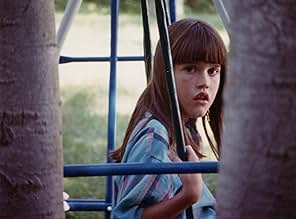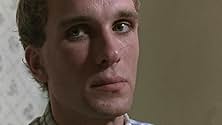Füge eine Handlung in deiner Sprache hinzuAfter a man suffering from schizophrenia is released from a mental institution, he attempts to get his daughter back from her adoptive family.After a man suffering from schizophrenia is released from a mental institution, he attempts to get his daughter back from her adoptive family.After a man suffering from schizophrenia is released from a mental institution, he attempts to get his daughter back from her adoptive family.
- Auszeichnungen
- 5 Gewinne & 6 Nominierungen insgesamt
Empfohlene Bewertungen
The use of sound in this film practically makes it worth watching in its own right, pun intended. In the critic's video essay that accompanies the Criterion release of this film, which is pitched to grad level film students (and that's not a complaint), Michael Atkinson remarks that the director uses "objective" sound, not "subjective" sound. It's true that the sounds that fill the film's soundtrack are given us from the external world, often through the protagonist's car radio and sometimes simply through the ether. But I'd disagree with Atkinson. I don't think this is just use of objective sound to a parallel the film's fragmented and "subject-less" subject and narrative. Yes, it's a different use of sound, but it's a complication of subjective sound, not a departure from it. After all we hear the soundtrack, and therefore we can't but believe that the subject hears them.
The use of sound here is interesting, I think, because the protagonist is not hearing them but producing them. We're given the sounds as he hears them, but they echo and resound within his schizophrenic mind, as they are the schizophrenic's world. Voices unattributed, perhaps real, perhaps recollected, but certainly not sounds that anchor the schizophrenic to reality. Rather, sounds that divorce him from the world, catching him as abruptly as an unexpected blow to the head. Short, sharp, shocks that knock about and bring into consciousness commands, put-downs, and other forms of verbal punishment that trouble us for their detachment. We don't know who's saying them. Which means we don't know why they are being said, which means (as Atkinson notes), we don't know what to think of them.
Where Atkinson hangs these sounds on a reel of film though, my sense is that they should be hung on memory, which is not a reel of film, is certainly subjective, if not multiply subjective, and is not objective in the slightest for the simple reason that memories can't be. Our schizophrenic protagonist's relation to sound is that he's caught in a compulsive listening, but cannot hear. The coup in Kerrigan's sonic genius, I think, is that in memory is the protagonist's pain, and it's a pain he suffers, often, without making the slightest of sound. But for the one that we hear.
There are serious flaws in this film: the screenplay is not well wrought and is too full of ambiguities, especially the entire serial child killing subplot. This is highly distracting. The acting is second rate, except for Greene's and MacDonald's performances. The film's strength lies in Kerrigan's insightful deployment of sound, setting and other effects to create the clinical realism of Peter's schizophrenic experience. Peter's intense, perpetual fear is palpable. Much of the film is shot in his car, where he has placed masking tape over the mirror, and newspaper over several windows, to fortify his privacy. The effect is an impacted atmosphere of paranoid insulation. Peter's hallucinated auditory experience garbled voices, static and other noise, unaccompanied by any visual representations is clinically valid. The voices and noise haunt him steadily. He tells Nicole he has had a radio device implanted in his head, with a transmitter in a fingernail. Earlier we had been exposed to his violent efforts to rid himself of these devices using scissors or a knife to gouge them out forms of delusion-driven self-mutilation that are uncommon but not rare in persons suffering the throes of severe acute psychotic episodes. The use of tight close up camera angles - viewing Peter from just behind his back or in profile in his car - heighten the sense of claustrophobia, the extreme narrowing of Peter's psychotic world. The setting - Miscou Island, in New Brunswick adds further accents of wildness and isolation to the overall tone of the film.
It can be argued that the detective's pursuit of Peter adds yet another source of paranoid fever to the film, though for me this conceit does not ring true. The fact that someone really is after Peter detracts from the power of his delusions. Other than this, Kerrigan can be congratulated for steering clear of the false visuals (realistically visualized imaginary friends and enemies) and other clinically implausible effects that Ron Howard used more recently in A Beautiful Mind. Anyone professional or lay viewer might rightly wonder how Peter could be discharged from the hospital in such poor psychiatric condition. Of course that happens every day in most contemporary short stay hospital settings, because involuntary treatment laws in most states prohibit keeping patients against their will except in the most extreme circumstances of immediate potential for violence. But we are given the impression at the start of this film that Peter had been incarcerated in a more traditional mental hospital, the sort in which people stay for long periods before discharge, until they appear relatively free of symptoms, sometimes longer. Of course these large old facilities are typically short staffed, keen clinical observation of patients may be scarce, and patients not uncommonly can muster a façade of normality to win their freedom.
The depiction of Peter's mother is also troublesome. Her grim withholding of affection for Peter and Nicole resurrects the spectra of the 'schizophrenogenic mother' a psycho dynamic fiction popular the 1950s and 60s that accused parents, especially mothers, of causing schizophrenia through self serving, unaffectionate regard for their children. This myth was laid to rest long ago, and it is a black mark against this film to see such a notion resurrected. It does not dispel the power of this negative maternal portrayal when, from a distance, we see the mother crying as she hangs one of her son's shirts on a clothesline near the end.
Clean, Shaven shares with David Cronenberg's film, Spider, the distinction of offering the most believable portraits of highly symptomatic schizophrenic experience that have been brought to the big screen. I prefer Spider because the acting is uniformly first rate and the screenplay is superior. Both films pull the viewer into an exquisitely painful, odd, lonely, and ultimately unrewarding world, into experiences that many moviegoers would, no doubt, prefer to avoid. Dramatically, this is a "C" movie, but the portrayal of schizophrenia rates an "A."
This is a very edgy little film. I didn't know what it was about when I watched it - I don't know I would have watched it if someone had described it to me. The story unfolds with very little dialogue and doesn't exactly have a plot to speak of. Instead the film puts us in the head of Winter and also comments on society's view of these people.
The audio track is the most disturbing part - full of electrical crackles over strong dialogue (from his life? From movies? We don't know). Most likely these are his `voices'. We also see things through his jumpy eyes are have visions like he does. The most disturbing part is where he removes his own nail to get the transmitter `they' put there. The relentless pursuit of the detective represents our mistrust of these people and the ending makes a clear judgement on his (our) actions. The final shot is a fine summing up of a child's innocence.
Greene (best known for Usual Suspects or Zed in Pulp Fiction) is really good in a role that a big star would have hammed up. He looks totally believable in the lead. Robert Albert is good as the sheriff and mixes his character's morality really well. The film is not a fun time to be had by all! It's plot is weak and the lack of dialogue, weird happenings and lack of explanation may frustrate some. However it is only 80 minutes long so it never drags, it captivates by being so very different and it is very thought provoking.
Overall it's worth a watch - it is edgy and interesting, not the most fun you'll ever have, but then it isn't meant to be.
anyway, if you wanna "feel" - not just see - what mental illness is all about, check this out.
Wusstest du schon
- WissenswertesPeter Greene's first line comes eighteen minutes into the movie.
- PatzerThe steering column shifter knob in Peter's car is missing. Then it reappears.
- Zitate
Peter Winter: I was in a, in a hospital bed, and I had been operated on. And they had put a, a small receiver in the back of my head and a transmitter in my finger. You know what they are?
Nicole Winter: A radio?
Peter Winter: Yeah, a radio. Anyway, to get at the transmitter, I had to take my fingernail off.
Top-Auswahl
- How long is Clean, Shaven?Powered by Alexa
Details
Box Office
- Budget
- 68.000 $ (geschätzt)
- Bruttoertrag in den USA und Kanada
- 26.351 $
- Weltweiter Bruttoertrag
- 26.351 $




























